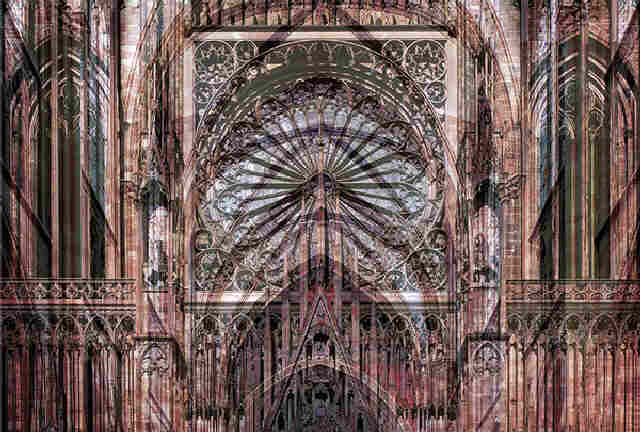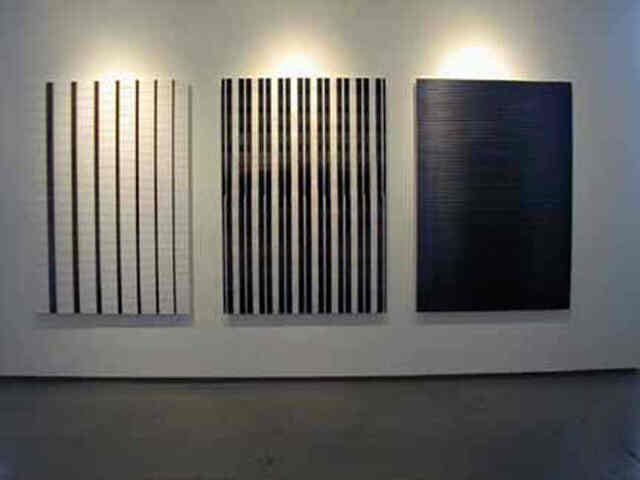| |
“ … we are not entirely
matter, nor are we entirely idea … through images, and in images,
we can comprehend opposites, grasp complex relationships, and ultimately
fathom both the interior and the exterior in their entirety. “
Roland Fischer, Kunstbunker, September 24, 1995
 |
|
|
Roland Fischer, a key figure in contemporary
German photography, had his second solo exhibition in the United States
at Von Lintel & Nusser Gallery
from September 6 to October 6. Well known for his monochrome explorations
of portraiture, this show of ten large-scale photographs included
the facades of gothic cathedrals and corporate high rises, buildings
of archetypal recognition. Fischer’s presentation of the gothic
with the modern is hardly spurious. The soaring, light-filled skeletal
volumes of the gothic cathedral were sources of inspiration for early
skyscraper designs by Berlin architects in the 1920s and 30s, in particular
Mies van der Rohe’s expressionist glass skyscrapers. This formal
continuity is revealed through Fischer’s superimposition of the
interior of the gothic cathedral with exterior views. In Fischer’s
combination, the stone façade weaves into the erupting forms
of the interior space. The stone exterior dissolves into an array
of geometric forms, reenacting the great transformations in architectural
form precipitated by the construction of the Crystal Palace of 1851,
a building now seen as the earliest precursor of the glass architecture
of the modern office building. The diamond-shaped verticals of the
pointed arches appear to peel open from the dark shell of the interior,
introducing an organic quality of movement into the static iconography
of the cathedral. As the image itself is crucial for Fischer, the
superimposition of interior/exterior opens up new visual territory.
In line with Fischer’s disruption of the stone façade,
Monet declared, regarding his Cathedral series, that “everything
changes, even stone,” to express his intentions to capture the
shifting conditions of light and vapor that surrounded the façade
of the Cathedral of Rouen.
 |
|
|
Fischer’s treatment of architectural form
is related to the formal language of portraiture that he developed
in his Los Angeles portrait series, 1989-91. The faces of these women
float within the blue or black frame of the customary suburban swimming
pool, a monochrome color plane with almost mathematical characteristics.
Freed from any personalized identification such as fashion, jewelry
or social context, the women’s individuality recedes while more
universal qualities show forth from their unadorned flesh-toned faces.
In similar ways, Fischer engages the facade of the building -- frontally,
sometimes framed against the stark blue sky and often completely isolated
from the local context of surrounding buildings. He rarely identifies
the building by name, preferring to leave the photo untitled with
only the name of the city as an index of place. What interests Fischer
least is the documentary aspect of photography. Instead, he captures
the flat planar quality of the modern office building as a purely
visual effect associated with the glass curtain wall, its imposing
height and reflective surfaces. The planarity of the façade
also refers to the flatness of the photographic image. In certain
photos, Fischer goes further by cropping to the boundaries of the
building’s façade so that only the vertical and horizontal
lines of the windows and structure remains framed. The overall visual
effect of this rectilinear treatment recalls the linear enclosures
of Mondrian, an artist who was both inspired by and responsive to
the architecture of the city. Fischer’s photographs of the modern
office building come close to releasing the photographic subject through
the color and line of pure abstraction. He uses the digital imaging
process to transform the photographic image into a starkly abstract
image, in order to “correct’ the waviness that results from
the steep viewing angles required to photograph tall buildings. The
monotone colors and bold lines of Fischer’s digitally-edited
photographs share certain visual elements of abstract or color field
painting, yet the distinctive surfaces of photography always remains
a prominent aspect of the work.
Photography’s move towards abstraction derives from a conceptual
narrative related to the social and cultural context of global capitalism
and the qualities inherent in digital production. New German photography
exhibits a strong fascination with surface, with rectilinear geometry,
with primary colors and shapes, with smoothness and evenness that
were the central preoccupations of modernist painting a century earlier.
Fischer’s architectural photos are monumental in size, most measuring
between 5 and 8 feet in length, the size constraint related to the
print limitations of the C-Print created from a digitally-produced
negative. The trend in contemporary German photography towards larger
formats is yet another direct engagement with abstract painting. Certainly
the lingering drive to legitimize photography as a fine art has also
certainly contributed to the oversized formats of the last decade.
An abstracted image invites a larger format, as it can be viewed close
up or far away and still make visual sense. It also heightens the
visual impact of color and line. Photographers first made the leap
into oversized formats during the heady art market of the 1980s, a
period during which Roland Fischer as early as 1980 and later Thomas
Ruff in 1986 first used oversized formats to show their portrait series.
The effect of the larger scale on content and image created a sensation,
and became the norm thereafter for other German photographers such
as Thomas Struth, Axel Hutte and Andreas Gursky. Fischer handles the
large format in the same way used as the Dusseldorf group, placing
white margins around the entire image and laminating the face of the
print to Plexiglas. The glossiness of the photographs self-consciously
presents the branding features of corporate capitalism, a brash, superficial
style that Fischer closely associates with Americanism.
 |
|
|
Architecture has long been the subject of photography,
originally due to the requirement of long exposure times, and later,
when picturesque views of cityscapes and the American skyscraper became
the norm. The skyscraper’s soaring vertical lines, glittering
steel frame and reflective glass façade appear tailored to
be pictured in a photograph. The contemporary office tower and the
rectilinear facades of corporate architecture also provide ideal subjects
for photography, a medium that is nothing but an exact recorder of
distinct volumes in space. In terms of German photography, Bernd and
Hilla Bechers’ documentation of industrial architecture through
a typological model provided the basis for new encounters with the
city’s built form for the fresh wave of photographers emerging
from the Kunstakademie in Dusseldorf. Clearly Fischer draws upon the
same imagery and architecture of corporate capitalism that has fascinated
both painters and photographers associated with “Corporate Realism.”
What differentiates his approach is his willingness to bridge the
stylistic distances, in this show for instance, between the Gothic
and the Modern, laying bare the roots of architectural abstraction
through the contemporary logic of the digital image. In Fischer’s
hands, the smoothness and precision of the digital image ultimately
call attention to the reproducibility of architectural style through
the manipulation of images and surfaces of the modern city.
Author's
Bio>>
|
|


